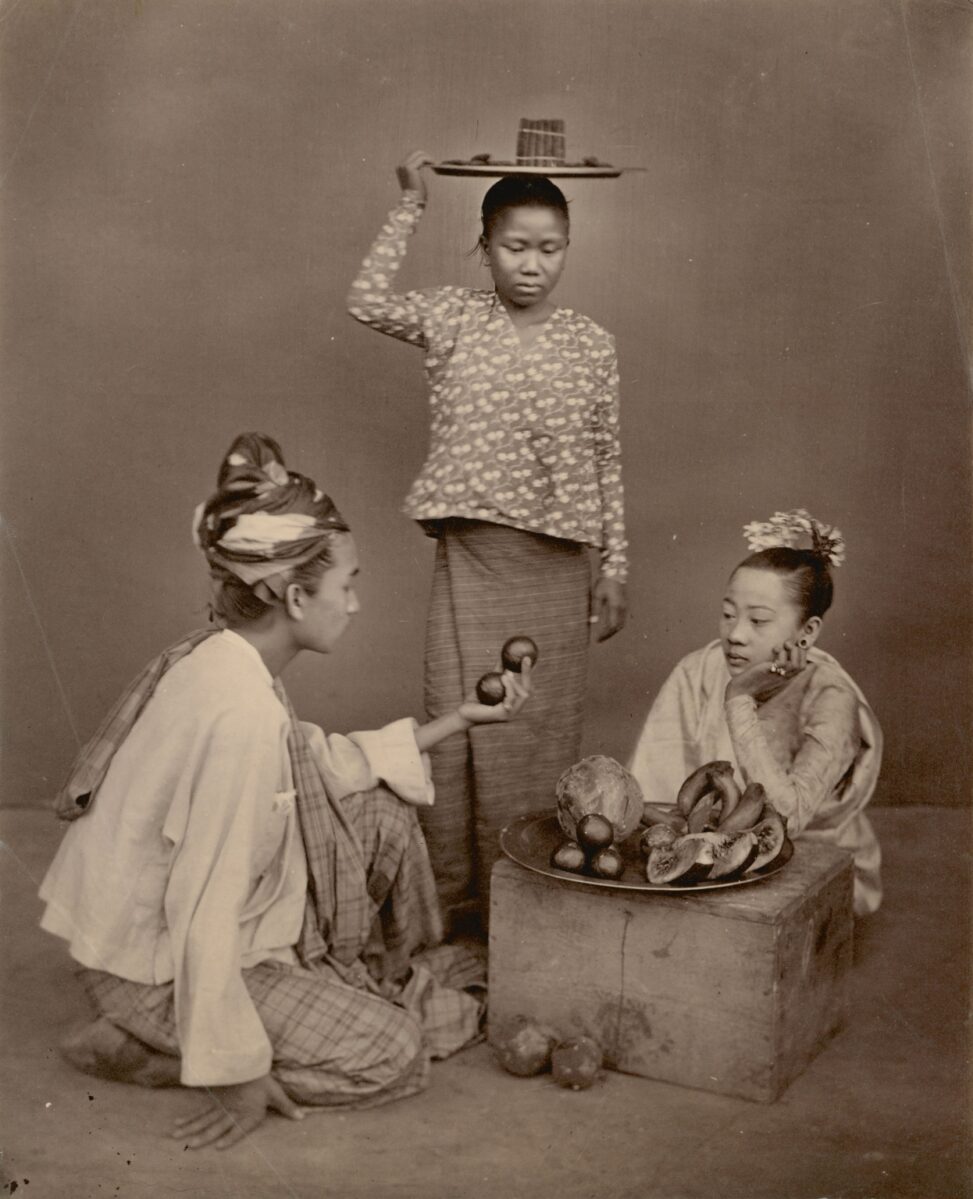Title: “Street Scene in Moulmein”
Date: 1885-1895
Location: Myanmar (Burma)
Source: Ira Wolff Collection
“Street Scene in Moulmein” is a photograph taken during the third Anglo-Burmese War, which began in 1885. This ongoing battle existed between the Konbaung Dynasty (the Burmese monarchy) and the British Empire. According to the Britannica article, “Anglo-Burmese Wars”, the Burmese people felt as though the British Empire was attempting to erase their religion, culture, and traditions, while the British Empire was attempting to gain control over the country. This image was taken by British colonists who lived in Burma during the late 1800’s. The clothing that the three subjects are wearing is the traditional attire of the Burmese people. When compared to the British colonists’ clothing in this same collection, the Burmese people don headpieces, patterned fabrics, long skirts, and loose-fitting bottoms. This further exemplifies the period within which this image takes place and how large the discrepancy was between the British culture and the Burmese culture.
After the Burmese people successfully resisted against complete British rule and cultural erasure, they experienced a period of economic growth that made them appeal to external countries (Keck, pg. 387). To capitalize on this, the British Empire took photos like “Street Scene in Moulmein”. This increased the tourism that visited this country and allowed for further growth of the Burmese economy. This photo was obviously staged, with the backdrop suggesting that these people were not on the streets of Burma but were in fact, on a set designed to attract European visitors. This photo resembles those designed for travel brochures, depicting the main attractions of a country but purposely isolating the subjects from any distracting background noise. The man in the photo is gazing at fruit that is native to the country, causing the viewer to be drawn to this as well. The woman sitting on the ground has a platter of other native fruits in front of her, acting as an advertisement for what foods the country has to offer. “Tropical flavors” were becoming a status symbol for Europeans, starting in the mid 1800’s, drawing in any British citizens who were looking to travel to Southeast Asia for this sought-after cuisine (Young, pg. 1). Finally, the standing woman has a platter of cigars resting on her head. As stated in the Havana House article titled “When was Cigar Smoking Most Popular in the UK?”, cigars gained popularity in the UK in the 1800’s, meaning that this would appeal to most British citizens during this time.
The three people in this photo have flat expressions on their faces, bare feet, and have their product resting on a box. This is most likely meant to depict these people in action and to show what they look like when they are in their element. If one were looking through a different lens, it may appear that these people are uncomfortable. They are being asked to pose to entice others into their country, something that had not previously been a part of their daily experience. In class, we learned about the sudden existence of colonizers in these Southeast countries. It is easier to visualize what this transition was like for the natives who lived in these countries through these photographs. While these Burmese citizens may have been actual street vendors, it was a foreign concept for them to be photographed for the masses. This act resulted in these staged collections that we can view today. There was a certain conflicting occurrence during this period in Southeast Asia where colonizers were simultaneously aiming to erase the existing religion and culture in these countries while also capitalizing off the foreign appeal that these people and these places had. The food, materials, and architecture that could be found in Burma was essentially being sold off to external places, while the people were displaced and dealt with traumas that continue to persist today.
Currently, the government of Myanmar desires a “homogenized” culture, leading to multiple human rights violations for anyone who attempts to rebel (Noreen, pg. 1). There is also an expectation that any area of the country that represents the “old” culture will be destroyed and replaced with the new regime. This appears to follow the same structure that existed during the late 1800’s: the powerful group in the country wanting to keep the appealing parts of the existing culture and erasing the parts that don’t align with the new rules. The Burmese people in this photograph had full lives, beliefs, and histories that are purposely being left out of the picture and it is important to dig up the pieces that were buried from this past.
Works Cited
Young, June. “The Introduction of Tropical Flavours into British Cuisine, 1850-1950.” Zum.de, 2009, https://www.zum.de/whkmla/sp/0910/chef/chef2.html.
Noreen, Naw. “Shan Culture in Burma Being ‘Erased’ – Myanmar.” ReliefWeb, 17 Nov. 2009, https://reliefweb.int/report/myanmar/shan-culture-burma-being-erased.
The Editors. “Anglo-Burmese Wars.” Encyclopædia Britannica, Inc., 23 Apr. 2023, https://www.britannica.com/event/Anglo-Burmese-Wars.
Ellie. “When Was Cigar Smoking Most Popular in the UK?” Havana House, Havana House, 6 Mar. 2020, https://www.havanahouse.co.uk/cigar-smoking-popular-uk-blog/#:~:text=While%20pipe%20smoking%20remained%20popular,the%20UK%20in%20the%201800s.
Keck, Stephen L. “Picturesque Burma: British Travel Writing 1890-1914.” JSTOR, Journal of Southeast Asian Studies , Oct. 2004, https://www.jstor.org/stable/20072606.
